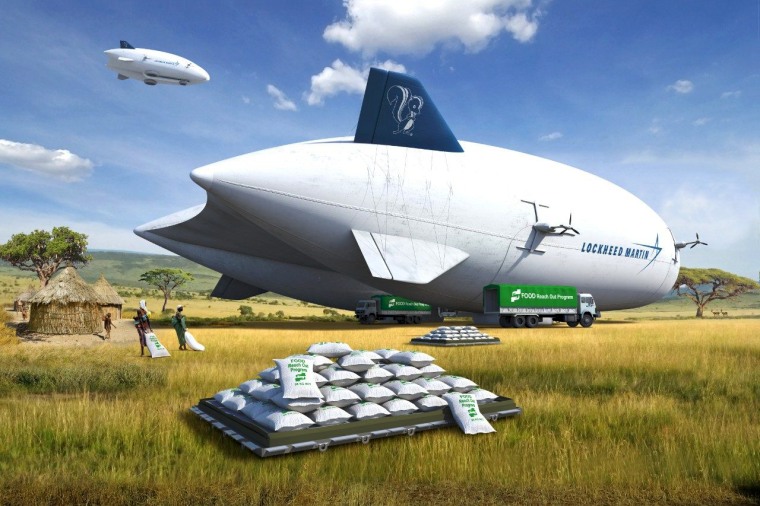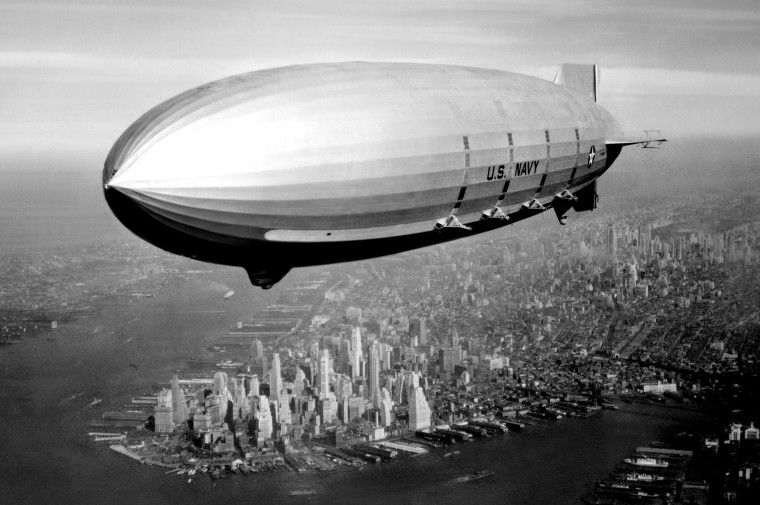The age of huge, ocean-crossing zeppelins came to an end in 1937, when the Hindenburg — the largest craft of its type ever built — erupted in flames while landing in New Jersey. Dozens died.
Now, more than 80 years later, the giant airships may be poised for a comeback — not for passenger service, but as an environmentally friendly means of delivering goods around the globe.
As proposed in a recent scientific paper, the new airships would be 10 times bigger than the 800-foot Hindenburg — more than five times as long as the Empire State Building is tall — and soar high in the atmosphere. They’d do the work of traditional oceangoing cargo ships but would take less time and generate only a fraction of the pollution.
“We are trying to reduce as much as possible emissions of carbon dioxide because of global warming,” said Julian Hunt, a postdoctoral fellow at the International Institute for Applied Systems Analysis in Laxenburg, Austria, and the paper’s lead author.
Old air currents, new technology
Hunt said the new generation of airships would get around by riding the jet stream, a powerful air current that circles the globe. He and his collaborators calculate that an airship a mile and half long could circle the globe in 16 days, hauling more than 20,000 tons of cargo while expending little energy.
The jet stream moves from west to east, so airships would only go in that direction. Hunt imagines them taking off from the United States, for instance, and crossing the Atlantic Ocean and Europe to reach Asia. The craft would then continue west across the Pacific to return home.

“I didn’t invent this,” Hunt said of the flight pattern. “The Hindenburg used to do it. They had this path which would go from New York to Tokyo and then come back,” he said. “The jet stream hasn’t changed much in 100 years.”
What has changed, Hunt said, is the technology available to build and operate airships. When the Hindenburg flew, operators had only the most basic means of predicting weather patterns and the crudest materials for fabricating airships. “They used to use cow intestines to build the gas bags,” Hunt said.
Today’s more durable materials, including carbon fiber, would make airships safer and less fragile; computerized weather-forecasting systems would let them steer clear of storms and help optimize the use of air currents.

But for all their high-tech advances, Hunt said, the new airships would still get their buoyancy from hydrogen, a highly flammable gas that is 14 times lighter than air. It’s the same gas the Hindenburg and the other big zeppelins used in the 1930s.
The possibility of another giant explosion has some pushing back against an airship renaissance.
“There is a resistance — because of the Hindenburg — to big bags of hydrogen,” said Eric Lanteigne, a professor of mechanical engineering at the University of Ottawa in Canada, who was not affiliated with the new research. He said that’s why the Goodyear blimp and other small airships now operating are filled with helium, the harmless gas found in party balloons.
But if helium offers a greater margin of safety, it’s expensive and hard to come by. It’s found only in pockets of natural gas deep underground, with its extraction usually a byproduct of highly polluting drilling. Hydrogen, on the other hand, can be extracted from water and so would much cheaper.
It’s possible to use wind or solar energy to power the process of extracting hydrogen from water, so that could be another advantage over helium. And since hydrogen is lighter even than helium and thus more buoyant, it would mean airships could haul more cargo.
Operating without a crew
To minimize the risks associated with hydrogen, Hunt envisions getting rid of the crew. The airships would operate autonomously — and would be loaded and unloaded by robots.
“The idea would be that the whole process would be automated so that in case you have an accident, no one will be injured — only the equipment and the cargo,” Hunt said, adding that some of the hydrogen in an airship could be used to power an on-board fuel cell that would spin the craft's propellers.
As an additional bonus, Hunt said, the fuel cell would generate as a byproduct water that could be released as the craft passed over regions hit by drought.
For all its potential benefits, Hunt’s airship idea has its critics. Lanteigne, who has written extensively about airships, said building such colossal craft would be an enormous challenge. “Based on my experience, it’s rather big,” he said. “There's a whole bunch of design challenges associated with building something that long.”
There’s also the fact that it might be hard to raise the capital for such an endeavor.
“Most airship companies are reluctant to speak about hydrogen because they will scare off investors," Barry Prentice, president of Winnipeg, Canada-based Buoyant Aircraft Systems International, said, adding that this was partly because the United States banned hydrogen in U.S. airships in 1922 and that, after the Hindenburg disaster, the rest of the world followed suit.
“There's this worry that since this is still on the books as being prohibited, nobody wants to take a chance to build an airship and then the government says, ‘No, you can't fly it because this is prohibited,’” he said.
But Prentice expressed confidence that, as airships grow more popular, regulators and investors will change their minds. “Once things get going and people are comfortable with airships, I think they'll very quickly move over to hydrogen,” he said.
That could happen soon. Airships are enjoying a bit of a revival, as manufacturers develop helium blimps for surveillance, luxury travel and shipping. Airships are particularly useful for carrying ore or lumber from mines or logging sites that planes and trucks can’t reach.
"In five years we're going to start seeing the first commercial cargo-carrying airships,” Lanteigne said.

Hydrogen airships are further off, though some firms are working on components for the craft. For example, Moscow-based RosAeroSystems has developed a chemical additive that renders hydrogen less flammable. Buoyant Aircraft is developing gas bags fit for storing the gas.
“I see no technological hurdles that cannot be overcome,” Prentice said. “It is really more a question of regulatory hurdles.”
Prentice said he thinks investors, regulators and the public will eventually come around to hydrogen. That, in turn, could open the door to larger airships capable of reaching higher altitudes while carrying more cargo.
“People are afraid of this much more than they should be. In the 40 years before the Hindenburg, all airships basically were filled with hydrogen,” Prentice said. “Yes, there were accidents, and they burned when they had an accident, and they hit the ground, but so did airplanes.”
Want more stories about innovation?
- Spider silk 'library' could hold secrets for new materials
- Ice-making submarine would pop out bergs to fight climate change
- This floating city concept is one way to cope with climate change
SIGN UP FOR THE MACH NEWSLETTER AND FOLLOW NBC NEWS MACH ON TWITTER, FACEBOOK, AND INSTAGRAM.

